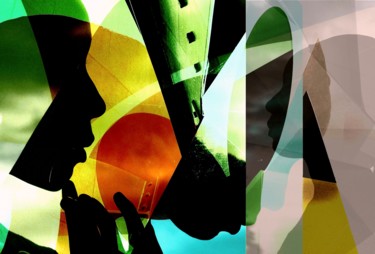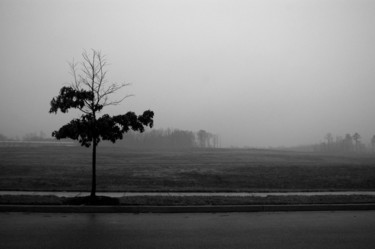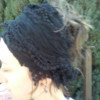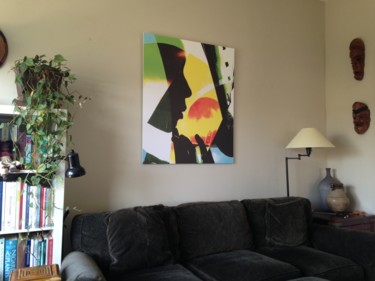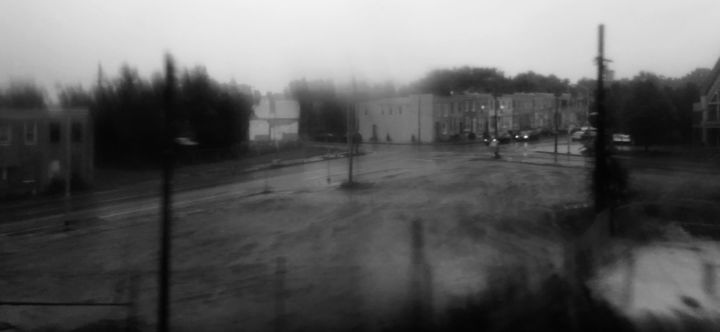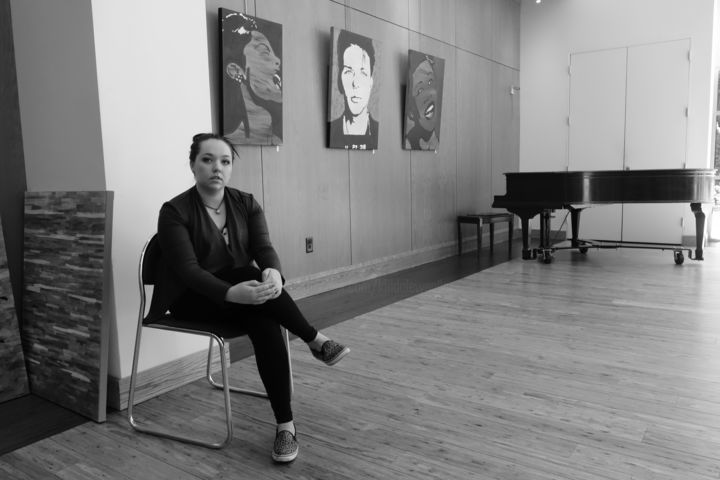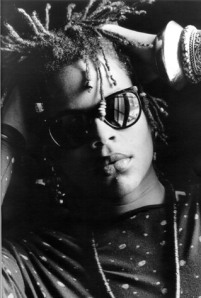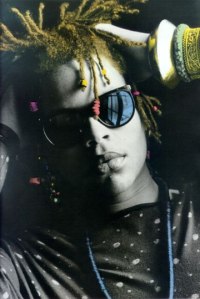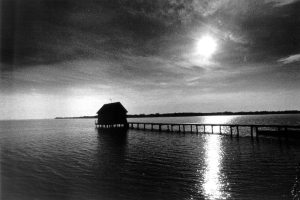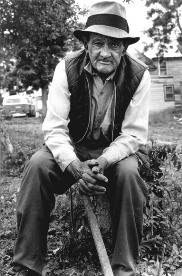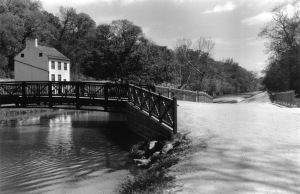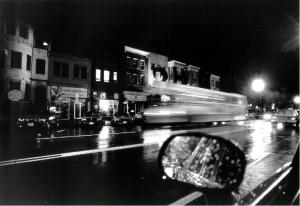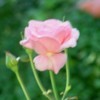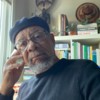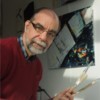Llewellyn Berry
Llewellyn Berry is a photographer who has specialized in two genres: landscape photography and semi-abstract expressionism. He works in black and white, with little interest in colorwork. Additionally, his work bears the influence of Georges Braques, Jean-Michel Basquiat, Willem de Kooning, and Paul Klee.
When photography illuminates the world around us, it reaches significant artistic heights. The artist's singular perspective sheds light on that fundamental aspect of our being - our collective and universal being. That image can serve as a constant reminder of the universe's uniqueness and the all-pervading beauty that exists around us.
Llewellyn Berry was born in the United States. He is employed in Middle River, Maryland. His work is included in numerous international collections.
Discover contemporary artworks by Llewellyn Berry, browse recent artworks and buy online. Categories: contemporary american artists. Artistic domains: Photography, Digital Arts. Account type: Artist , member since 2013 (Country of origin United States). Buy Llewellyn Berry's latest works on ArtMajeur: Discover great art by contemporary artist Llewellyn Berry. Browse artworks, buy original art or high end prints.

Artist Value, Biography, Artist's studio:
Abstracts • 63 artworks
View allOrchid Studies • 14 artworks
View allAs of August 2017, these are newest orchid studies. Apparently, we have discovered the perfect light, air flow, and interior climate in which our orchids will flourish.
Landscapes • 14 artworks
View allLlewellyn Berry
Photography | Several sizes
Commemorative Posters from Art Exhibits beginning, 1980 • 2 artworks
View allI made the Kodalith photograph of her gallery sign. The show was with George Tolbert and myself.
Llewellyn Berry
Photography | Several sizes
Public Art • 9 artworks
View allLlewellyn Berry
Photography | Several sizes
Llewellyn Berry
Photography | Several sizes
Llewellyn Berry
Photography | Several sizes
Where my art work is collected • 7 artworks
View allIn 2017, more of my recent work is being displayed at home. I am grateful to my wife, the artist who shows interest in my work and has sought to make it part of her design for our home. She is a consummate interior designer and her artistry is exquisite.
Llewellyn Berry
Photography | Several sizes
Llewellyn Berry
Photography | Several sizes
Llewellyn Berry
Photography | Several sizes
Llewellyn Berry
Photography | Several sizes
Llewellyn Berry
Photography | Several sizes
Calder Original Abstract Images • 12 artworks
View allI liked the color tone and decided to add the color to many of the images I had captured.
This addition of color would contribute later to my total immersion into adding a myriad of color to variant shapes and rotations to layered Calder images.
Llewellyn Berry
Photography | Several sizes
Llewellyn Berry
Photography | Several sizes
Llewellyn Berry
Photography | Several sizes
Llewellyn Berry
Photography | Several sizes
Llewellyn Berry
Photography | Several sizes
Llewellyn Berry
Photography | Several sizes
Llewellyn Berry
Photography | Several sizes
Original Alexander Calder Study • 20 artworks
View allMy photographic interpretation of Calder's sculpture began in 2010 when I launched a three-year photographic study of it. I was struck by the sculpture, but also its juxtaposition with the sky and the museum's facade. I photographed the sculpture from dozens of angles on dozens of occasions, using my camera vertically and horizontally and using a crystalline sky, the facade of the Hirshhorn Museum and the Sun as elements that enhanced my abstract expressionist interpretation.
This gallery holds my original black and white interpretations of Calder's Two Discs sculpture.
Llewellyn Berry
Photography | Several sizes
Black and White 1968... • 69 artworks
View allMy serious pursuit of photography actually began in Fairfield, Iowa when I was in college and needed to have feature news photographs more quickly than the staff photographer could provide them. I was News Editor and as a weekly, w didn't need hard new pics, just features.
I learned how to process black and white film and print and from then on, it remained a steadfast passion.
The photographs in this gallery represent early images and a developing aesthetic in a black and white mode.
From 1968 until 1984 these and many other photographic images helped to strengthen my visual literacy and produce portfolios that represented a keen sense of what light could do to make an ordinary photograph, extraordinary.
Llewellyn Berry
Photography | Several sizes
Llewellyn Berry
Photography | Several sizes
Llewellyn Berry
Photography | Several sizes
Llewellyn Berry
Photography | Several sizes
Llewellyn Berry
Photography | Several sizes
Recognition
The artist is recognized for their work
The artist's works have been noticed by the editorial staff
Exercises the profession of artist as a main activity
Biography
Llewellyn Berry is a photographer who has specialized in two genres: landscape photography and semi-abstract expressionism. He works in black and white, with little interest in colorwork. Additionally, his work bears the influence of Georges Braques, Jean-Michel Basquiat, Willem de Kooning, and Paul Klee.
When photography illuminates the world around us, it reaches significant artistic heights. The artist's singular perspective sheds light on that fundamental aspect of our being - our collective and universal being. That image can serve as a constant reminder of the universe's uniqueness and the all-pervading beauty that exists around us.
Llewellyn Berry was born in the United States. He is employed in Middle River, Maryland. His work is included in numerous international collections.
-
Nationality:
UNITED STATES

- Date of birth : unknown date
- Artistic domains: Works by professional artists,
- Groups: Professional Artist Contemporary American Artists
Ongoing and Upcoming art events
Influences
Education
Artist value certified
Achievements
Activity on ArtMajeur
Latest News
All the latest news from contemporary artist Llewellyn Berry
Artistically Speaking...
Posted on February 20, 2017by Llewellyn Berry
For more than 40 years I had been primarily an urban black-and-white photography artist, walking through the city studying the visual effect of natural light across objects, people, and scenes. The city inspired me, driving my art with every new person I met, every new item I encountered, and every street I walked.
Not much has changed, since 2014, except everything outside my door. Two years ago, I moved to Middle River, Maryland. Unsurprisingly, my work has taken a turn toward the pastoral. My streets are now footpaths and I see more animals than people. I am now inspired by the way the forest cuts the sky, the change of seasons on the river, and the rich visual variety of an area I call the Middle River Moors.
The “Moors” have hills and berms and dune-like areas with grasses against a backdrop of tall saplings. Sunrise through an early morning fog or the implicit weight of a late afternoon Sunset provide striking visuals of the land and its forests. I studied the beach at Gunpowder Falls State Park and the expansive minimalism offered by shoreline, sky, sparse flora and wooden jetties.
My most recent landscape portfolio includes photographs that capture subtle light inferences in backgrounds that are representational but subtle enough to evoke moods with contrast given to sharper, stronger tonal images in the foreground.
Continuing to create black and white imagery, I have captured the area in all kinds of weather conditions, as well as moonsets and sunrises in late summer, autumn, and winter. I have photographed the forest edge, the forest trails, reservoirs and swales and conservation basins.
Secret paths leading through fields and forests evoke visions of early indigenous peoples traversing the land and water long before the landing of foreigners. In my artist’s imagination and vision, I craft many of my photographs with this in mind. The land changes as natural light rises and falls during the course of a day and with seasonal changes the dramatic effects nature presents is stunning in its subtlety and the notion that it has been here for centuries.
These images are designed to be provocatively calm. I make specific choices to craft each image, as I look through the viewfinder. This conscious selection of aperture, shutter speed and ISO at the very beginning is critical to my process and my product, with much self-editing of what I see before I press the shutter button. As I say to my students: “The Review button is your best friend.” I review my last shot in order to decide whether it is what I had in mind or do I need to further edit my controls. Invariably a move to one side, or to come in or move back; shift from horizontal to vertical, I will find subtle new ways of seeing the scene in front of me.
These visually stunning images provide a pictorial view of nature reminiscent of early photographers in the late 19th Century, capturing the tonal range of a crystalline blue sky, along with layers of land in the foreground leading to a background of trees and their subsequent silhouettes against the horizon.
The city has its appeal and its energy invigorates as it electrifies daily life. Nature in its understated brilliance stimulates in quieter, calmer and a more stately way and as I capture that dynamic I am one with it and feel a different vibration and life energy.
Next…A New Life in Baltimore ???
Who Knows From Where Inspiration Comes
Who Knows From Where Inspiration Comes
Posted on April 24, 2011by Llewellyn Berry
Happy Easter everyone.
I’m not quite fully returned to the blogosphere but I’m closer.
When I can I am digitizing more prints. I’m crafting more written subjects that I hope will encourage aspiring photographers. Most recently one of my McKinley students has revealed a website of his photography that is a tremendous entry onto the scene and I am very proud of his work and his effort.
This is a young man who was a Biotechnology major at McKinley. I don’t even think I ever saw him with a camera. Well, so it goes sometimes. He was Valedictorian of the class of 2008 and began a career at MIT (although I and several friends encouraged him to go to Stanford). However, who among us has empirical knowledge of where we will end up (temporarily at least). The “…best laid schemes of mice and men, gang aft agley…” That’s what Robert Burns actually wrote.
So here is Obinna Ukwuani beginning an adventure in photography. I trust I and a cadre of my closest colleagues can assist this young man with this journey.
So, until I return with both feet firmly implanted in blog-city, I leave you with this tidbit:
The following photograph was taken by my father, who was also a scientist – a chemist by training with advanced degrees in Chemistry from Catholic University. As I sat on the (Chippendale stool) and smiled at him (somewhat) quizzically, I can only imagine that I was somewhat mesmerized and inspired at the same time at what I saw him doing both there and at Freedmen’s Hospital where he was Chief of the Clinical Laboratories.
Llewellyn L. Berry, III
Washington, DC
Photograph by Llewellyn L. Berry, Jr
c.1950
Who knows from where inspiration comes.
Obinna Ukwuani as a Biotech Major
McKinley Technology High School
Washington, DC
2008
Ken Lambert Seize the Moment
Ken Lambert: Seize the Moment…
Posted on March 21, 2011by Llewellyn Berry
One of the first photographs I remember Ken Lambert making…capturing, was when I gave an assignment that sent him and his classmates downtown. As I said before, I sent them to the National Mall or just downtown, in general, to see and capture urban life. The juxtapositions of people and their things, as well as their habits, make for great photographs. Especially when we look the Masters – W.Eugene Smith, Henri Cartier Bresson, Gordon Parks, Moneta Sleet and so many others. Bresson, in particular, was an enormous influence on my photographic vision and of course that being a primary orientation for me, I passed it on to my students. After all the photojournalism class was part of the Urban Journalism Workshop. It was always a useful assignment because, in each issue of 1310 our feature news magazine, we tried to provide a showcase for those photographers who were able to produce photo essays or photo stories of urban life.
Ken processed a roll of film, made the contact sheet and there it was – a shot of someone with their head stuck in a mailbox. The woman or man, I forget which, just had his head inside the mailbox. No reason; well, no reason to any of the sane passersby, but we were sure he had a reason. His head was not stuck; it was just inside the mailbox. We didn’t particularly care; it made for a great photograph.
Ken had seized the moment. He had captured a moment in urban life. He got it and he got it early. He understood what was meant by the “decisive moment” and he always kept that as his photographic prime directive. Ken went on to do extraordinary photo work. There was a photo story on instrumentalists at the Duke Ellington School of the Arts. He captured the violin instructor, Ramona Matthews taking the time to correct and encourage a promising student. He photographed Dr. Calvin Dash with a student vocalist.
There was his time at Syracuse where he did photo study work in 4×5 format – extraordinary. Then he went to work for the Washington Times and Associated Press here in Washington, DC. He has moved to Seattle to work for the Seattle Times.
This is a link to his work. He is an extraordinary news photographer and I am extremely proud of him. http://seattletimes.nwsource.com/html/photogalleries/photography202/1.html
Ken Lambert, in his own words:
I remember a picture, I think it was Gina’s, [Gina Stevens] of several people cutting jagged forms in wheelchairs, that struck a very compassionate chord for me. And I remember that picture of the mailbox but can’t find it. The sad truth is I was able to cover a lot of ground, literally, in your class because I had something most other kids didn’t: a car. My mother had just died and I got hers.
The Ellington photos (attached they are incorporated into a college layout exercise) were THE
Unidentified Instrumental Student
Duke Ellington School of the Arts
Washington, DC
1979
breakthrough for me in your class. They weren’t just portraiture, they were moments…especially the series of a frustrated voice teacher (Dr. Dash, as I remember) striking his forehead when the student couldn’t get to where he wanted him to go. The printing was finally exactly what I wanted in terms of contrast and midtone, not to mention it was the first time I bounced a flash correctly (on the sax player).
Dr. Calvin Dash
Vocal Instructor
Monica Otal
Accompanist
Duke Ellington School of the Arts
Excerpt from 1310 Magazine
The Urban Journalism Workshop
1979
Top Photo
Carolyn Kellock
Cello Instructor
Duke Ellington School of the Arts
Excerpt from 1310 Magazine
The Urban Journalism Workshop
1979
Bottom Photo
Ramona Matthews
Violin Instructor
Duke Ellington School of the Arts
Excerpt from 1310 Magazine
The Urban Journalism Workshop
1979
My other fond memory (no, not the one stealing a brick of Tri-X) was the scavenger hunt. I did a tombstone rubbing of Sousa’s grave and also collected water from the Anacostia River to prove I went there. As a somewhat sheltered white kid from NW I think it was the first time I ever set foot near Anacostia. Going “where you don’t normally go,” which I’ve made a career of, is as essential to photojournalism as a camera. On a humorous note, I think I won the scavenger contest, collecting everything first. Another student challenged the authenticity of my river water, yelling, “That water’s too clean,” which of course it wasn’t!
************************
*Lew’s note: In 2001 I asked Ken for a recommendation as I was trying to save my job at Ellington after 15 years. This is what Ken wrote:
Ken Lambert Pictures
P.O. Box 11045 o Washington, DC 20008
To Whom It May Concern:
I would like to express a special appreciation for my high school photojournalism instructor, Lew Berry. I was a student of Lew’s almost 20 years ago, while a senior at Wilson High School, here in Washington. I was always interested in photography, but Lew took me far beyond that, not only exposing me to classic photographers like Arnold Newman and Gordon Parks but showing me how I could make photography something much more than a hobby. It could be a lifetime adventure.
Under his guidance at the Penn Center, near McKinley High School, I thrived during my senior year, even though it was a tough time for me because I had just lost my mother. Lew edited and published my first student newspaper pictures of worth: the groundbreaking for the Vietnam Veterans Memorial. Later, he recommended I apply to Syracuse University’s photojournalism program. I got in and graduated four years later, cum laude. Today, after a 14-year newspaper career, I am currently in a new job, as a staff photographer with the Associated Press, covering the White House and Capitol Hill.
Lew had an important impact on my development, showing me that being a photographer takes skill, vision, courage, and constant hard work. He also showed me that other facets of human creativity are important to perfecting one’s own craft, as a photographer. Lew supplied a steady stream of pictures for inspiration, but he also played lots of jazz as part of my creative learning experience. The music helped me through the long hours in the darkroom, trying to make that perfect print.
I always admired Lew because he is not only a great photographer but an articulate one to boot. An excellent writer, and insightful speaker, I realized to be like Lew meant having to work on more than just photography. Part of being a success as a photographer would entail being an overall success as a person. Writing skills, people skills, total commitment to one’s craft, and above all, honesty, mattered.
Over the years I’ve kept in touch with Lew. Remembering my roots is important. It is disturbing to me when I think of Lew not having an opportunity to teach because he has always had something very important to contribute here. I know all his former students who have gone on to successful careers would agree. And there are many of us.
I think what makes Lew an outstanding teacher is his vision and positive energy. I can’t remember him ever being negative about anything. He would always make my mistakes into learning experiences. I share Lew’s vision: that people are not just objects to be captured on film. They have souls and stories to tell. I think what I learned early in Lew’s class, and what has stuck with me for 20 years, is an appreciation for the people beyond the images we create of them. Photography may be what we do to tell a story, but it is never more important than people. Not even a top dollar education at Syracuse taught students this. But Lew did.
Sincerely yours,
Ken Lambert 3/29/01
Ken Lambert, Lew Berry
Washington, DC
Photo by
Linda Berry
1988
Capture the Casual Moment
Posted on March 3, 2011by Llewellyn Berry
I guess it’s not a secret that I no longer have a camera. Stuff happens and I believe it happens for a reason… well, enough of that for now.
No camera and of course there are countless pictures I see as I scan my everyday. That’s just the way stuff unfolds. You make plans to go out during the day. It’s raining and instead of staying in and watching old movies, you say no and make plans for the museum. Of course, before you leave you check the listings and find that all of your all-time favorite films are playing non-stop on TCM.
Anyway, right now I’m in New York City and I’ve been all over Manhattan and Brooklyn and it has been like a movie unfolding scene by scene for me to photograph and write about and just enjoy now and later on film. Um, no camera.
This brings me to those of you who do have cameras. Keep that instrument with you at all times – especially when you visit friends who live in houses or apartments where you’ve noticed the light is particularly striking.
I am at my wife’s daughter’s home in Brooklyn. I was standing in the kitchen this morning and their cat was sitting in a stream of sunlight (I bet you know where this is going, huh?). I had my cell phone (remember, no camera) and I said what the hell, I’m going to take this picture. I turned the phone to the camera setting. The camera came up. I raised the camera up and the cat got up and moseyed on out of the sunlight and into her little hut. I think I heard her giggle and saw her thumb her nose at me as she went in it.
Anyway, keep your camera at the ready. There are so many casual pictures out there that in time become extraordinary because you pay attention to light and composition and you are not afraid to take the picture – capture the moment that YOU feel. That is the important thing – YOU feel it.
I’m not suggesting that every Tom, Dick, and Harry will FEEL a casual picture and later on find they have captured a masterpiece…but some will and you won’t know unless you take the picture – capture the moment that YOU SEE and YOU FEEL.
I was visiting my friends the Byrds Lora and Kimble. Lora and I were just chatting. She offered me a glass of wine. She joined me and we continued chatting, laughing. They were such great company (they moved to Delaware).
As she held the glass of wine, I raised the camera (I was shooting color for some reason that day) and captured a moment that I saw and that I felt. I love the picture. It’s simple; simply composed. I love the colors in it; they are muted and soft and relaxed and they say a lot about a moment that meant something to me and perhaps may have a universal appeal.
Hands Holding a Wine Glass
Washington, DC
1982
Girl Eating Watermelon
Posted on February 23, 2011by Llewellyn Berry
As a photography teacher, it is incumbent on me to provide opportunities early in the class cycle for students to easily find pictures or scenes and subjects to photograph. Early in the class I would talk about photographers who inspired me. Ansel Adams, Roy de Carava, PH Polk, Henri Cartier Bresson, James Van Der Zee, Dorothea Lange, Moneta Sleet and of course many others who may only have a print or two published in an anthology. All of these photographers made pictures of people in ordinary situations but the pictures become extraordinary due to the rendering of the photographer. The uses of light, composition, exposure, etc. all contribute to taking the ordinary and transcending it photographically.
On this particular day, I had a private photography student and we ventured out to the Farmers Market in DC on New York Ave. In those days, the market was thriving on Saturdays filled with people selling all kinds of meats and produce. The produce sellers were usually truck farmers from rural Virginia or even further south, as far south as North Carolina.
The market was in full bustle that day and my student found much to photograph. I was shooting with a Mamiya Sekor Twin Lens Reflex C330 which was 21/4 format. It produced negatives that were 21/4 square. It was a larger negative than the 35mm and gave greater detail in a square format. It was a great camera and I loved it.
There was so much to shoot but the Mamiya C330 roll was only 12 exposures so I was being very conscious of what I chose to shoot. There were lots of children about and kids generally love to have their picture taken. Shortly, two boys ran over to me after seeing the camera and struck a pose. It was really funny but in that instant, I saw the picture they made.
One boy looked directly into the camera lens and had his hands on his brother’s shoulder. The other boy with his baseball cap turned backward and as he chewed on a sugar stick, he looked away from the camera. That was the shot and I only took one. They were happy. I was happy and I moved on to look for more subjects. I did talk to the father of the boys and they were truck farmers who had come all the way up from North Carolina to sell at the Farmers Market.
I took several more shots and with only a few exposures left, I saw the boys’ sisters. One was very pregnant and the other had a large wedge of watermelon in her hands. She turned as she munched on the watermelon and the photograph was undeniable. It became one of my all time favorites and it has times caused some controversy.
The girl is eating watermelon. Her pigtails stand out and there is melon juice running down her hands and the dress she is wearing is soiled and reminiscent of poor farm people. However, for me it is her eyes that capture the audience. It is the girl’s eyes that have led me back to this photograph time and time again.
Girl Eating Watermelon
Farmers Market
Washington, DC
1979
Now one might ask: What about the photograph of the boys? Well, interesting story why I do not post it here. I made the print and I made many prints. I sepia toned it. I made Kodaliths of it. I matted it and framed it. Lots of folks have it. What I did not have, was permission from the parents. I didn’t think anything of the picture at the time I shot it – just that I liked it. I did not take it seriously and get a “Model Release” for it.
One day there were visitors to my apartment. I think they came with a former student. The picture of the two boys hung proudly among my other photographs and when this person entered and saw the photograph, they said: “Wow, how do you happen to have a picture of…” He actually called them by name. I was stunned. I said: “You know these boys?” and he said, “Yeah, that’s …” He called them by name again. Yes, they were from North Carolina. Now, I must admit that the rest of that encounter is a blur to me. Nevertheless, I stopped showing that photograph and certainly did not sell it.
But, it’s a great photograph. You should see it… Perhaps one day It'll pop up on my Blog. Is there a statute of limitations that applies here???
Hand Coloring and Photo Masking
Hand Coloring and Photo Masking
Posted on February 22, 2011by Llewellyn Berry
For my photographic development to arrive at simply wanting to see the world in black and white, I had to make many stops along the way. It is a natural progression and I suspect most artists as they search for their “voice” follow similar paths.
One of my stops was in the world of hand coloring. I was intrigued with this technique because it was used so often in the early days of photographic reproduction and portraiture that it had for me a certain allure. It was color but not real color it was hand colored – man-made color – added color. Okay, you get what I mean.
I used Marshal’s Photo Coloring Pencils. It is a box kit still available via the Internet.
It was so easy to use and the pencils were used on black and white photo prints. Take a black and white print put a little of the Marshall’s print preparation solution on the area you want to color, let it dry then use the pencil to color the area. Use a Q-tip to remove excess pencil residue. That’s it. Seriously; that’s all there is to it. It’s best to use a print made on fiber –based paper. It won’t work too well on resin coated stock.
Below is first the black and white photograph followed by the hand-colored version.
Ife Ajaniku
Black and White Gelatin Print
Washington, DC
c.1982
This is the hand colored print.
Ife Ajaniku
Hand Colored Black and White Gelatin Print
Washington, DC
c.1982
The incidences of color are subtle and exist in a netherworld context of black and white and added color.
The next photograph started out as a black and white gelatin print.
New Orleans Café Table Setting
Adams Morgan Neighborhood
Washington, DC
1984
From there I used a liquid photomask gelatin solution on the area of the flowers on the table.
I then Sepia Toned the entire print, but the mask prevented a change in the flowers.
After the Sepia Toning, I hand colored the area of the flowers on the table.
New Orleans Café Table Setting
Hand Colored, Sepia Toned Gelatin Print
Adams Morgan Neighborhood
Washington, DC
1984
Khamla Somphanh Dance Montage
Posted on February 19, 2011by Llewellyn Berry
Shortly before graduation at Ellington in the spring of a year I do not remember, as I continued my photographing of dancers, I began a study of a young dancer, Khamla Somphanh.
Unfortunately, there was no time to pursue the study because of senior academic as well as arts finals and prom and graduation.
However, from these few photographs, the possibilities can be seen in terms of fuller length-whole body shots in a multiplicity of poses and movements. There would be close-ups of hands and legs in the midst of twirls etc. The possibilities are limitless.
Again, I encourage beginning photographers to seriously consider the possibilities in exploring and thus exhausting subjects they find.
Montage
Khamla Somphanh
Dancer
Duke Ellington School of the Arts
Washington, DC
c. 1988
On the River
Posted on February 13, 2011by Llewellyn Berry
There must be a correlation between my fiery (Leo) nature and many of the photographs I make. They seem to have a calmness about them. Perhaps inside this cauldron, there is a battle being waged between the fire and the ice; perhaps. I feel both have a rightful place in my artistic temperament and each seems to recognize kindred emotions that are visceral, as well as contemplative I don’t find a distinction between the visceral and the contemplative. It’s just that the visceral evokes a sense of urgency, intensity – fire and the contemplative one of thoughtful quiet serene even. They both find a coalescence that leads the visual to the making of a photograph. And, at any given time each one will come to the fore…
Many years ago my wife who is an extraordinary designer was contracted to provide landscape design for a client whose property rests on the banks of a river in Maryland. The property was extraordinary. How blessed the family was to have such an idyllic backdrop to their lives.
How blessed we were to be offered the opportunity to visit this property frequently.
My wife and her associates were actually creating a beautifully landscaped forest with perennials that would bloom seasonally for many years to come. It was spectacular in its design and each spring when we returned it was indeed a beautiful celebration of nature and the ability of humans to enhance natural beauty in the world.
I walked the property and made many photographs. From the banks of the river, I looked out on the water as I traveled over the property looking for subjects to photograph and avoiding the snakes (shudder).
I took many photographs, but one day as the sun rose on a thinly clouded morning, a silhouette of the boathouse and the pier along with a gradation of texture and tone from the sky and the water gave me a picture I thought was pretty interesting.
Soon I will be displaying color photographs and writing about how black and white can often transcend color for a myriad of reasons.
But, for now, here is a photograph I made in Harwood, Maryland.
Boathouse on the Bay
Harwood, Maryland
1994
Once Upon a Time
Posted on February 12, 2011by Llewellyn Berry
Once upon a time I stood crooked by the lake
As weeping willows sang peaceful anthems
Near where I wrote dirges in the sand suggesting
The nonchalance of my middle age.
I could stare at the sand or the sea remembering
Nothing of the pain in my heart over losing loved ones.
I could see distant tall ships carrying clouds
On the horizon, their rise and fall majestic
Like passengers aboard who aimed at the new world,
The promised land, where shores of sand clean,
Water blue and clear and
Fish, who bravely spoke the poetry of forgotten souls when
Asked about the secrets of the universe.
And in the quiet dawn when sunrise
Quickens its pace to greet the sky, I pondered the endless words
To anthems sung and whose meanings were made real
Like the sun and the sand and the wind that took away my breath
As I lay searching for answers to questions posed by fishes.
I whispered and listened through the wind that blew
Over the sand and the sea – once upon a time.
Winter Pond
National Arboretum
Washington, DC
1985
Dreams
Posted on February 12, 2011by Llewellyn Berry
Dreams are whispers stepping through doors
Unlocked when sleep seems likely
But unrest rules the night and
Plays and songs and verse and madness
Peek into corners
Reserved for quiet moments
And other mutterings
When no one sees you.
Whispers are quiet dreams stumbling over intentions
Pausing in the night
Wondering if truth really belongs there,
Faithful to the tale , honest to the whisper
Played in familiar, phantom notes
Dreaming, and whispering
Riding the wind of night tales with
Murmurs of delight.
Dreams are poachers of reality that whisper and lie
Cloaked in familiarity, lost
In twilight’s mist
Listening for voices.
A Foggy Dreamy Night
Catholic University’s Campus
Across from the John Paul II Center
Washington, DC
1984
Dancers
Posted on February 12, 2011by Llewellyn Berry
Very shortly after arriving at Ellington, I realized that I had been given an extraordinary gift. I was a photographer in the midst of one of the most artistically inspiring places on earth well, at least in Washington, DC.
I wasn’t teaching photography. I was teaching radio production and broadcast journalism and although I was moving toward my goal of a functioning radio station/production studio, I was still a photographic artist with a wealth of potential images all around me. There was the theatre department all costumed and dress rehearsing. There were young sculptors and painters and printmakers in studios, jazz and classical musicians practicing in beautifully lit solitary spaces and then there were the dancers. My oh my, the dancers… They just seemed to move with the music and the air around them. There they were all chatty and playful and serious in classes in the morning and then somehow magically transformed in the afternoon into these gazelles and Giselles pirouetting and pointing and poised like fauns and so much more. I didn’t know where to start first.
Well, I shot all over the place. I photographed theatre rehearsals and performances of all the productions. I have photographs of all of them. I shot the young painters and sculptors in their studio classes and got pictures of the work that was done. The saxophonists and the guitarists and the jazz ensembles and the pianists…I got ‘em all. The flutists and the violinists…
And once again, there were the dancers. The Dance Department Chair, Lynn Welters, asked me to photograph the seniors and that just led me to photograph so many of the rest of them and of course I gave them the prints. After all, they were doing me a favor. I was having the time of my photographic life.
Ms. Welters was the consummate Ballet Mistress, tapping out times with the long stick, shouting out French ballet terms and directions and corrections.
Toulouse Lautrec and Edgar Degas are two of my favorite artists and especially their work of dancers – Degas’ Dancers and Lautrec’s work at the Moulin Rouge. It’s more than the movement; it’s also the dancers with disciplined and gifted bodies or instruments getting to the spot and once they arrive. I mean they move to reach a point (so to speak). If I capture them getting there, I’m happy with that. Capturing the motion is cool. I’m even happier when I get them having arrived at the spot. That’s when body and head are in complete alignment. The dept. chair said I had a knack for getting that moment…” the decisive moment”.
I had never heard of Lester Horton, but Ellington had a teacher who did just Horton technique. Lloyd Whitmore; whoa, this brotha’s choreography was extraordinary and I loved photographing his work. I had to go to lots of his rehearsals and dress rehearsals because I would get caught up in watching the dance – the movement. You know, I’m the photographer, right. I’m supposed to be totally into making the pictures. Well, I was but I had to go and watch. The thing was, each time I would go to another rehearsal I would see something else I wanted to shoot and of course, I always had my camera with me. My eyes would be all big and the music would get me going and then the dance…oh, the dance!!! It was just extraordinary and I was getting it on film.
Lloyd Whitmore
Dance Instructor
Duke Ellington School of the Arts
c.1988
Among the dance department instructors there was Sandra Fortune. This is how things, in general, come around and specifically in DC. Years before we arrived at Ellington the Urban Journalism Workshop’s feature news magazine, 1310 did a story on Sandra as a student and I believe it was a piece on the Capital Ballet. I sent one of my students over to get pictures and he had shots of Sandra. Well, here I was photographing Sandra, the dance instructor at Ellington.
That was the other blessing about Ellington for me. Not only were the students incredibly talented and accessible, their teachers were outstanding and true celebrities in their own right. The faculty at Ellington never got, in my opinion, enough of the recognition it deserved. These folks were and are extraordinary artists.
One of my all-time favorite photographs is the one I made of Lloyd Whitmore and Sandra Fortune on stage at Ellington. I think it captures the passion and the professionalism of these two outstanding dancers.
Dancers
Lloyd Whitmore and Sandra Fortune
Duke Ellington School of the Arts
c. 1988
Woman on a Persian Rug
Posted on February 12, 2011by Llewellyn Berry
Not only did I photograph just about everything I could find inside my house, in the backyard or down the street, but I also experimented with different films and developers. One series of experiments was with Kodalith materials. I have boxes and boxes of Kodalith negatives and positives, 8×10 and 11×14.
Kodalith film was sheet film and processed with the Kodalith A&B developer, removed the intermediate tones from black and white film images and left only stark black and white images when printed. The process actually is a bit more involved than that but not much.
Essentially, I took a black and white continuous tone negative and exposed the image to a sheet of Kodalith film producing a positive image. After that film dried, contact printed it onto a fresh sheet of Kodalith sheet film producing a negative image. I then took the negative Kodalith sheet of film and contacted it onto a sheet of photographic paper and producing a positive image.
Sounds complicated but it isn’t really. Essentially the printing is a sequence of negatives producing positives producing negatives and so on and so on.
There is a calmness of the image because of the woman looking down at the highlighted pattern in the rug. Even in the midst of the starkness, I believe the tilt of her head evokes calm. The image might not work if there was more detail in the woman’s face. Perhaps there is a certain degree of anonymity in the indistinctness of her face.
There are three dominant elements in the photograph: One is the highlighted face and arms. The second is the highlighted design on the rug and the third is the negative space of the rest of her body. So, in essence, the three elements make for a simplistic photograph but powerful in the starkness of the light and dark elements.
I got to a point where I had found a very inexpensive supply of 11×14 Kodalith sheet film and I made Kodalith negatives and positives of all my favorite 35mm negatives. The process didn’t always work but it was fun and sometimes I surprised myself with the results.
Woman on a Persian Rug was the first serious Kodalith print I made as an artistic expression.
Woman on a Persian Rug
Washington, DC
1970
Jack Hawes, Tobacco Farmer
Posted on February 10, 2011by Llewellyn Berry
Jack Hawes
Virginia Tobacco Farmer
King and Queen County
Newtown, Va.
1978
I seek the simplicity of life
Of folded hands,
Crossed legs
A bottle of beer;
The quiet memories of the past…
Send me your well wishes:
The rain to freshen the air,
A prayer for the sun to shine
And a smile from the widow-lady
As she walks to the mail box
When I met Jack Hawes, I asked if I could photograph him. He said if I got him a six pack. I did and I took lots of photographs. After I made this print of him, I gave him a print. He took a hammer and nailed it to the side of his porch. He would point it out to visitors when they stopped by. I felt honored.
In this photograph I like Jack’s grizzled beard; I like his rumpled hat and shirt and most of all I like the glint in his eye.
The verse I wrote was prompted by a picture I took of him with his legs crossed as he relaxed on his porch. The picture is one of many I made of him.
Jack Hawes
Virginia Tobacco Farmer
King and Queen County
Newtown, Virginia
1978
Jacob Lawrence
Posted on February 9, 2011by Llewellyn Berry
Although I had taught a formal photography class from 1971 – 1986, during the last couple of years from 1984-86, I had begun to teach radio production and broadcast journalism. For background purposes, print expenses had gotten a bit out of hand and since we really operated from grants we wrote, there was a need to find an alternative to printing costs. We morphed from literary arts to radio and television scriptwriting and production. My task was to become better versed in radio production and broadcast journalism. I spent two summers working at WKYS-News, WPFW, Radio Smithsonian, National Public Radio and WTOP Radio News. What I learned from really outstanding folks was just amazing. I began to love radio and radio production. I could not wait to start a full-blown program in radio production.
I wrote a proposal and received a modest array of audio production equipment and I set the studio up in one room of the television studio we already had at Penn Center. This was 1985 and there was some talk of us moving to Duke Ellington. One day, DCPS Superintendent Floretta McKenzie was at Penn Center on her way to a taping at the Media Center. I was on the elevator with her. We were old friends from the early days of our program when she and then Superintendent Vincent Reed were extremely instrumental in the formation and the continuity of the Literary Arts and Media Program.
In the elevator, I asked Mrs. McKenzie when we were finally going to move to Ellington. She thought for a minute and said it should be this year and that she really wanted a writing program at the Ellington school of the arts. We moved in the summer of 1986.
At Ellington, I was teaching radio production and broadcast journalism, but there was only a makeshift studio with production equipment set up on long tables and there was no sound booth. So, in the back of the enormous classroom, I was given, I actually had a small photo studio set up with background paper and lights. It was quite nice.
One day I was downstairs in the art gallery at Ellington when in walked Jacob Lawrence, the Harlem Renaissance artist. I was stunned. One of the great benefits of teaching at Ellington was the arts celebrities who frequented the school to give Master’s classes to our students. I met all the Marsalis family. I stood next to Stevie Wonder when he donated a piano to the school. I said, “Hey Stevie Wonder, my name is Lew Berry.” He said, “Hey Lew Berry.” How cool was that, right????
Anyway, here was Jacob Lawrence. I had been to every exhibit of his work in DC. The last one was at the Phillips Collection and it was enormous and I was thrilled. Here he was in the flesh. One of the arts’ faculty met him in the gallery and introduced me to him. He was early for his Masters’ class and I asked him if he had a few moments to sit for a few photographs.
He graciously said yes and we proceeded to my classroom where as I said, I had a small photo studio setup.
I was shooting with a Hasselblad at that time and believing that I had a short amount of time, I knocked off a quick roll of 12 shots.
I processed the film that evening and I liked them all, but there were two that I particularly liked. One he was holding his glasses and looking serious. The other his hands – those magnificently gifted hands – were resting on the little table in my studio and he was just smiling.
It was a really nice shot because he was so nice and he was so gracious and accommodating. I only got to spend about a half hour or so with him, but it was one of the big thrills of my time at Ellington.
I made several prints, matted one and sent it off to him in Seattle. I believe he received it about a month before he passed away.
Jacob Lawrence
Harlem Renaissance Painter
Photographed at the Duke Ellington School of the Arts
c.1990
Finding One's Voice
Posted on February 9, 2011by Llewellyn Berry
The Teaching “Voice”
I think I found my teaching “voice” around 1979 or so. I was teaching at the Lemuel Penn Career Development Center. I taught Photojournalism in the Urban Journalism Workshop in the morning and Creative Photography in the Literary Arts Program in the afternoon. We recruited our students from all of the high schools in DC Public Schools and interviewed prospective students for enrollment. Later when we arrived at the Duke Ellington School of the Arts and became the Literary and Media Arts Department, we “auditioned” our students…potatoes, potahtoes… In any case, there (Penn Center) is where I believe I found my teaching “voice”.
I didn’t know what “voice” was until I was at Ellington and all of the arts teachers talked about students finding their “voice”. It wasn’t singing, not that kind of “voice”. It was something more intrinsic. It was clearly about something you were good at and something else that was difficult (at least for me) to define. The more I contemplated it and listened and watched when the term was applied, finally, it struck me: “Voice” is from my mind, my body, my heart, my soul “and finally what life is asking of me”; that, which is giving my life purpose and meaning.” It’s that last part that provided the “aha” moment for me later in life.
So, it was Interview day at Penn Center for Literary Arts and Media. I had gone to lunch and interviews were scheduled for the afternoon. Returning from lunch, I arrived at the third floor where we had our main classes and where we conducted our interviews. The place was packed with students; I mean packed. The students had to sign up for the class they wanted. The list for my photojournalism and creative photography class had the most signatures, which was no big surprise; it very often was the most popular (lots of kids in the 70’s and early 80’s were into photography, but then I asked the kids how they heard about the program and what brought them that day and more than a few of them said, they had heard about Lew Berry. They wanted to take photography from Lew Berry.
I was flabbergasted. I guess I do sound perhaps a bit too braggadocio to tell this story now, in this format, but it truly was around that time when I began to believe that I might be a good teacher…a good photography teacher. It also helps illustrate the point of the essay.
My approach to teaching photography was to first understand that it was a skill to be learned through practice. One could read books and get the technical part, but it is the art of “seeing” and the refining of that art that ultimately determines the success of a photographer. I taught kids how to use their particular camera and told them to read the manual. I helped them understand light and time and how the two equaled an exposure. If the camera had a meter in it, I showed them that when the needle was in the middle, it indicated theoretically, “a good exposure” and that was a very good beginning point. However, “seeing” the light and where the light was touching and from that, determining the f/stop and the shutter speed was essential. Suppose the camera’s battery failed and there was no spare. Then I said, “Go shoot a roll of film”. That was it. Everything from then on was built on that simple direction: “Go shoot a roll of film” Of course next was developing that film but we took our time getting there. I tried to demystify it for them. Very often they had parents or relatives who were photographers and not to downplay the role played in their lives, I suggested that they take what the relative practiced and what I was teaching and put the two together because no two photographers went about their craft the same way. The student would soon develop his own method and protocol for shooting, developing and printing.
Throughout the years former students continue to tell me that I inspired them and I continue to do so even to this day.
That’s the teaching “voice”. It seems to be what my life or “life” in its spiritual context, was expecting of me.
I am particularly blessed to have impacted so many lives.
The Photography “Voice”
There is a wooden box that sits in my living room. I use it for the storage of my little things – mementos of my esoteric life. This morning the light from the window falls on the surface. At one end of the box, there is an orchid in a small vase. The vase casts a small shadow on the box. The orchid’s leaves are green and to some degree translucent. I can see the veins in the leaves. Some of the leaves, as they twist and turn toward the light (phototropism…thank you 7th-grade science) and so there are shadows created. The shadows and the highlights of the leaves occur naturally as the orchid grows and ambient light rests upon it.
I have pre-visualized a photograph. If I had a camera, I would capture this moment. The light will change; it will fade and the configuration of highlights and shadows will also change. Perhaps the next scene created by the next phase of ambient light will be an even more profound image to me. However, in the here and now, the light that rests upon the leaves of the orchid along with the evenly-lit surface of the box, is the photograph that occupies my visual creation at the moment.
I can remember train trips when I was much younger and looking out the window at night as the train passed through warehouse districts of small towns, I was fascinated by the single lamp over the back door of a warehouse and the triangular light it shone on the warehouse parking lot or back stairs. There must have been a million of them as the train wound its way through countless villages and towns, yet each of those scenes resonated with me as a scene of immense visual intimacy – just a simple light shining down on a virtually non-descript stairway of four steps, but they made a lasting impression on me about the profundity of simplicity.
Once, I walked into the New Orleans Café in Adams Morgan many years ago and as I moved toward a table by the window, I passed a table which just sat by itself and the simplicity of it struck me as profound…in a simplistic way. It actually shouted to me, very quietly.
New Orleans Cafe
Adams Morgan
Washington, DC
1984
Therein lies the profundity of simplicity and the persistence of “voice”.
Fishing at Haines Point
Posted on February 7, 2011by Llewellyn Berry
In one of the many shoeboxes of family photographs that traveled from closet to closet to crate to crate and now sit quietly stored at my grandmother’s house where my cousin tends to the estate, lies a small black and white photograph of me. I am wearing a Washington Senator’s baseball cap, a YMCA Summer Day Camp tee shirt, khaki shorts, high top Keds and I’m holding a fishing rod. On the end of the fishing line is a fish that seems to flapping, wriggling and such. I think I might have been eight or nine. I am with my mom and dad, cousin, uncle and aunt. We are at Haines Point and we are fishing. I am learning to fish and I am digging it. I mean I am really into it. I can bait my own hook with a fat, juicy bloodworm from the little white cup we got from the bait shop. I know how to cast my line. I can take the fish off the hook after I catch it and yes, I can reel that “sucka” in with the best of ‘em.
Later in life, when I was a little older, my dad and I would go fishing in the ocean off the shore in New Jersey. Much later in life, one of my fondest things to do was to sit on the rocks in the Shenandoah River fishing for Bass. All of that started way back when I was a kid with my folks at Haines Point fishing with my little rod from the dime store…yet another “kit”.
Fishing at Haines Point was a summer ritual for my family. Mom would make sandwiches and a family-size thermos of ice tea (with a dash of grape juice), deviled eggs, and potato salad. That was great and we did it several times during the summer months.
Driving along Haines Point years later looking for photographs to make, I got out and walked. I came upon men and youngsters doing just what my family did. They were fishing at Haines Point. Of all the scenes I saw, this one I liked best of a single older man having caught a fish, he removed the hook and set the fish free. He had enough for the day and although you don’t see that in the picture, for me it is the silhouette makes the photograph.
I made this photograph which is backlit, about 11:00 in the morning (you can see where the sun is) and for me it freezes a moment in time…in my time when life was just about a sandwich, a deviled egg a cup of ice tea and a fish flapping on the end of a hook…on a Sunday with my family.
Fishing at Haines Point
Washington, DC
1975
Sunset on the Mall
Posted on February 4, 2011by Llewellyn Berry
It may seem as though many of my photographs, at least the ones written about in this space, have occurred out of pure happenstance. Well, that’s really not the case. There have been serendipitous factors in their creation, true, but they all have originated not just from my accumulated visual literacy and experience, but just by being in an environment or a situation where interesting images can occur.
I have a recent acquaintance who I believe is an excellent photographer. I find her photographs taken in many of America’s National Parks absolutely stunning. It helps that she was there in those Parks. She travels by RV to the Parks with her husband through the west and mid-west, but it is also a tribute to her ability to see and compose the photograph or as it has been stated before, “pre-visualize” the photograph.
You can have expensive equipment – the best money can buy, but if you are sitting in a lawn chair in your backyard, you severely limit your photographic subject material. You don’t eliminate it; you just limit it. In future essays, I hope to display photographs taken of spring budding trees and shrubs in the spring and trees and leaves in the fall. If your backyard has trees and shrubs you have a wonderful potential for exciting seasonal photographic studies.
Sorry, I actually have digressed.
This essay set out to discuss putting oneself in an environment where exciting photographic images can occur. When I was teaching, I very often sent my students down to the National Mall, especially on weekends. There is always something going on down there. There are kites flying, dogs chasing Frisbees, touch football games, pickup soccer games. A little further south and you can see the tourists in paddle boats. There is a wealth of interesting photographic images to be made down on the Mall.
I was on the Mall on late afternoon and headed to my car to leave for the day. I had been shooting and I don’t think there was anything noteworthy on that particular roll of film as I think of it. The further I traveled toward my car, the more the sun began to set. I just happened to turn and look toward the west and there was the sun setting just at the bottom of the Washington Monument.
Now, on the surface that might seem like an ordinary image to photograph, especially on the National Mall in Washington, DC, however, because the sun was setting, it was behind and backlit certain Mall icons. There was the Smithsonian Castle with its flagpole and of course the Monument – each a familiar image. And, then there was that setting sun, which turned out to have another distinction, which would not be revealed until I developed the film and made the contact sheet.
There just near the bottom of the Monument and just at the horizon line was the circular glow of the setting sun. It was barely noticeable on the contact sheet and I knew I would have to “burn” it in for it to have any real distinction. “Burning-in” in photo printing parlance means to give a specific area of a print additional light during exposure. One makes the original exposure, leaves the paper in the easel and exposes the paper again only this time covering all of the paper with a piece of paper or one’s hand but allowing additional exposure to that specific image area of the paper.
The challenge of burning in that setting sun was to do so and not have leftover darkness surrounding the sun. By that I mean the resulting image needs to look like it had not been burned in.
I think I achieved that.
Sunset on the Mall
National Mall, Washington, DC
1982
A Perfect Storm
Posted on February 2, 2011by Llewellyn Berry
Sometimes there is a “perfect storm” – a coalescence of all the elements of a well exposed negative. The composition works, there is detail in the shadow area as well as the highlight area. The lines direct the eye to points of interest. Sometimes after you find this image even before you make the exposure you just sigh with a big smile…take the picture, dummy, before the light changes because of an errant cloud…Ok.
I ventured out one day along the C&O Canal west of Georgetown, looking for images on which light might play an integral role in creating an effect that struck me, as interesting. Under a bridge, there was a jogger putting on a shoe and the shadow of the bridge, as well as the bridge itself, created a crosshatch of lines that was an okay image. I took the shot; I took a few.
There was graffiti on the wall under the bridge. It too had a distinct shadow on it and the message plus the shadow plus the lines of the bridge created an okay image. I took the shot…ho hum!
I continued down the path and then, there it was. It stared at me. It cried out to me, “Lew take this picture; I’m yours and you will be really happy with me for a very long time.” So, I did and yes, I have been happy with it for a very long time. It was indeed, that “perfect storm” of composition and exposure.
This is a photograph that has all the classic components. There is a complete tonal range from pure white to pure black and all the grays in between. The composition is well balanced and roads and bridge paths – lines – that direct the eye to the house. From the house, the line of trees and the path direct the eye to a vanishing point into the distance. There is detail in shadow areas as well as highlight areas. There is movement in the ripples of the water in the canal.
This was not luck… well, unless you count the serendipity of the beautiful sky, the clouds, and the ripple of the water. The “not luck” part is in the recognition of the potential for a photograph. It is the pre-visualization that guides the capture of this image. I saw it immediately and although I took two shots of it, the second shot is virtually identical to the first. I think there might be a quarter of an f/stop difference between the first and the second.
However, this was initially recognizing the scene; then it was the camera’s meter measuring all the important areas of what was in the viewfinder. This was film not digital.
As I look at the print, there is a distinct difference between the image white and the paper white – clear borders all around. The bridge empties the eye onto the towpath.
Often images emerge like that but it is the ability to recognize them that is attributable to the practice of photography. I have had students who in class produced a contact sheet which had one really interesting frame amidst 35 others that were not so interesting. Yet, what was important was that they saw that one. It was my task to build on that one they saw and point out and encourage the same visual dynamic as they approached the next roll of film and the next photo assignment. What was important to me and ultimately to them was the process by which they were seeing. I looked at the first shot, then the second and so on and so on. It was that process and that fluidity that was essentially the making of visual literacy.
With the shot or two shots of Fletcher’s Boat House, I really didn’t need the second shot but I couldn’t believe my eyes that this shot didn’t require some extra work. Nope. It was a “perfect storm”.
Fletcher’s Boat House
C&O Canal, Washington, DC
2000
Metro Bus on the Move
In the SLR, non-digital camera, the aperture’s function is to allow a certain volume (quantity) of light into the camera to expose the film. The shutter’s function is to control how long, that volume of light will expose the film. So, there is light plus time equals exposure.
When the photographer is confronted with an idea for a photograph based on what he sees in front of him, the machinations and manipulations of camera controls are made in a matter of seconds. Leaves are blowing. It’s a windy day and I want to show the motion of those leaves as they float through the air. With the non-digital camera, I must slow the shutter, and then adjust the aperture to where the meter indicates I have a correct exposure. The motion of the leaves is an element of time, represented by the shutter. Time is the constant and the f/stop is the variable and in this case, the variable controls the ultimate meter adjustment that will equal exposure.
The motion of an automobile is shown also by slowing down the shutter and adjusting the f/stop accordingly.
Below is a photograph I made one evening on 18th street in the Adams Morgan neighborhood of Washington, DC. I was sitting in my car waiting for a friend. It was raining. I liked the raindrops on the side view mirror in juxtaposition with the larger image in the viewfinder’s rectangle of the street scene…the lights, the buildings and of course the well-known painting of Toulouse Lautrec’s, Aristide Bruant on the façade of Café Lautrec.
As I sat there in the driver’s side, I casually made f/stop and shutter adjustments to make the photograph. I was not particularly concerned with shutter or aperture. I think I may have set the shutter at 125 or so and let the f/stop determine the exposure for the meter. Then suddenly I noticed an approaching Metro Bus. I immediately decided I would show the motion of the bus. In order to do that I had to very quickly change the shutter speed to a slower speed and adjust the aperture accordingly. I believe I slowed it to a 60th or 30th of a second. The result is below.
My understanding of digital cameras is that a similar adjustment of the kind I made that evening could not have been made so quickly.
Metro Bus on the Move
Adams Morgan, Washington, DC
1984
This is one of my favorite photographs. I like the motion of the bus. I also like the juxtaposition of the raindrops on the side view mirror, the detail in the buildings along the road. In addition, there is a curious figure in the middle of the road that I did not notice during the exposure. It was some time afterward, in fact when I looked at the print. It actually looked like a humanoid figure crossing the street. Could it have been an actual human crossing the street? Nah, it was just a reflection of streetlights and rain. Still, it offers an item of controversy when all the elements of the photograph are considered.
Reviews and comments
